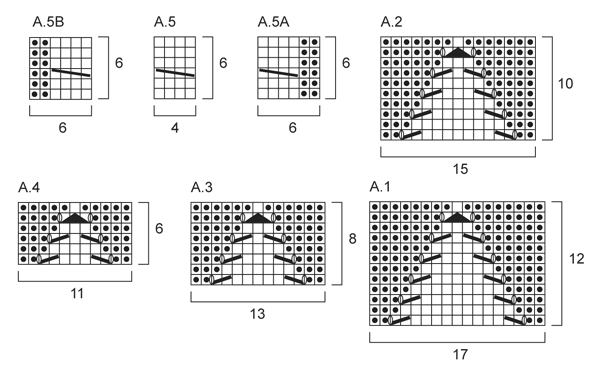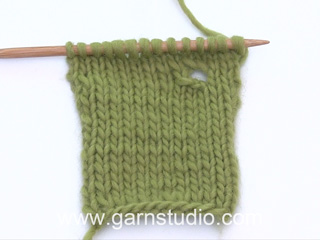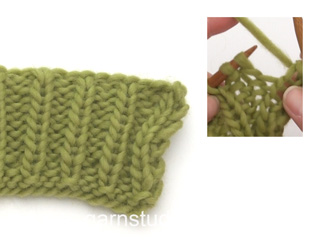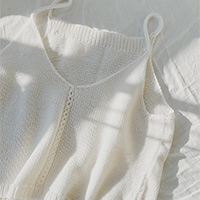Allison |
||||||||||||||||||||||
 |
 |
|||||||||||||||||||||
Knitted DROPS fitted jacket with lace pattern and cables in ”Cotton Viscose” and ”Kid Silk”. Size: S - XXXL.
DROPS 145-1 |
||||||||||||||||||||||
|
GARTER ST (back and forth on needle): K all rows. 1 ridge = 2 rows K. NOTE: All edge sts in the sides are worked in garter st. PATTERN: See diagrams A.1 to A.5, diagrams show all rows in 1 pattern repetition seen from RS. The pattern is different in size S - M - L - XL/XXL - XXXL, the pattern on the picture is size M. SHORT ROWS: RIGHT FRONT PIECE: Work short rows every 5 cm / 2" vertically as follows: Work 18 band sts from RS, turn and K back. Then work over all sts on row as before. LEFT FRONT PIECE: Work short rows every 5 cm / 2" vertically as follows: Work 18 band sts from WS, turn and K back. Then work over all sts on row as before. BUTTONHOLE: bind off for 1 buttonhole on band on right front piece. 1 BUTTONHOLE = K the first 5 sts from mid front, bind off the next 2 sts. On next row cast on 2 new sts over the bind off sts. -------------------------------------------------------- BACK PIECE: Worked back and forth on circular needle. Cast on 109-117-125-133-151-159 sts (includes 1 edge st in each side) on circular needle size 5 mm / US 8 with 1 strand of each yarn. Work in GARTER ST - read explanation above - for 3 cm / 1⅛" (1st row = RS). REMEMBER THE GAUGE! Work next row from RS as follows: 1 edge st in garter st, 18-22-26-30-18-22 sts in stockinette st, work A.5A 1 time, * A.1, A.5 *, repeat from *-* a total of 2-2-2-2-4-4 times, work A.1 and then A.5B 1 time, work 18-22-26-30-18-22 sts in stockinette st, finish with 1 edge st in garter st. Continue in pattern with 18-22-26-30-18-22 sts in stockinette st and 1 st in garter st in each side. Work A.1 3 times vertically in total - but on last row from WS (= 12th row), dec in every repetition of A.1 as follows: K the first 2 tog, K 6, P 1, K 6, K the last 2 tog (2 dec sts in every repetition of A.1 = 15 sts remain) = 103-111-119-127-141-149 sts on row. Then work A.2 between the cables. Work A.2 3 times vertically in total - but on last row from WS (= 10th row), dec in every repetition of A.2 as follows: K the first 2 tog, K 5, P 1, K 5, K the last 2 tog (2 dec sts in every repetition of A.2 = 13 sts remain) = 97-105-113-121-131-139 sts on row. Then work A.3 between the cables. Work A.3 2 times vertically in total - but on last row from WS (= 8th row), dec in every repetition of A.3 as follows: K the first 2 tog, K 4, P 1, K 4, K the last 2 tog (2 dec sts in every repetition of A.3 = 11 sts remain) = 91-99-107-115-121-129 sts on row. Now piece measures approx. 39 cm / 15¼". Then work A.4 between the cables until finished measurements. When piece measures 41-43-44-46-47-49 cm / 16⅛"-17"-17¼"-18"-18½"-19¼", cast on new sts for sleeve in the side as follows: Cast on 16-14-12-10-10-8 sts at the end of the next 2 rows = 123-127-131-135-141-145 sts. Work next row as follows: 5 edge sts in garter st, 30-32-34-36-24-26 sts in stockinette st, work pattern as before, 30-32-34-36-24-26 sts in stockinette st, finish with 5 edge sts in garter st. Then continue pattern mid back with 30-32-34-36-24-26 sts in stockinette st and 5 sts in garter st in each side. Work A.4 11-12-13-14-15-16 times vertically in total (piece measures approx. 67-70-73-75-78-80 cm / 26⅜"-27½"-28¾"-29½"-30¾"-31½", finish on last row in A.4). On next row from RS (1st row in A.4), bind off the middle 15 sts for neck and finish each shoulder separately. On next row from neck, bind off 1 st = 53-55-57-59-62-64 sts remain on shoulder. When A.4 has been worked 1 time (= 6 rows), loosely bind off all sts (there are 12-13-14-15-16-17 repetitions of A.4 vertically in total), piece measures approx. 70-73-75-78-80-83 cm / 27½"-28¾"-29½"-30¾"-31½"-32¾". RIGHT FRONT PIECE: Worked back and forth on needle. Cast on 60-64-68-72-81-85 sts (incl 1 edge st in the side) on circular needle size 5 mm / US 8 with 1 strand of each yarn. Work in garter st for 3 cm / 1⅛" (1st row = RS). Size S - XL: Work next row from RS as follows: 18 sts in garter st (= band sts), work A.1 and A.5B 1 time, 18-22-26-30 sts in stockinette st, finish with 1 edge st in garter st. Continue in pattern with 18-22-26-30 sts in stockinette st in the side and 18 band sts mid front. Size XXL and XXXL: Work next row from RS as follows: 18 sts in garter st (= band sts), work A.1 and A.5 1 time, then A.1 and A.5B 1 time, 18-22 sts in stockinette st, finish with 1 edge st in garter st. Continue in pattern with 18-22 sts in stockinette st in the side and 18 band sts mid front. All sizes: When piece measures 5 cm / 2", work SHORT ROWS - see explanation above. Continue to work pattern as on back piece and dec 2 sts in the lace patterns the same way as on back piece. When all dec are done (= 6-6-6-6-12-12 dec sts in total), 54-58-62-66-69-73 sts remain on row. Continue with A.4 and cables with short rows until finished measurements. When piece measures 41-43-44-46-47-49 cm / 16⅛"-17"-17¼"-18"-18½"-19¼", cast on new sts for sleeve as follows: At the end of next row from RS, cast on 16-14-12-10-10-8 sts = 70-72-74-76-79-81 sts. Work next row from WS as follows: 5 edge sts in garter st, 30-32-34-36-24-26 sts in stockinette st, work pattern as before, finish with 18 band sts. Continue pattern as before until piece measures 45-47-49-51-53-55 cm / 17¾"-18½"-19¼"-20"-21"-21⅝", now bind off for BUTTONHOLE - see explanation above. Work pattern as before until piece measures 49-51-52-54-55-57 cm / 19¼"-20"-20½"-21¼"-21⅝"-22½". On next row from RS, bind off the first 17 band sts = 53-55-57-59-62-64 sts remain. Insert 1 marker at beg of row (marks where to beg pick up for collar). Continue with pattern as before with 5 sts in garter st in the side and 1 edge st in garter st mid front. Work A.4 a total of 12-13-14-15-16-17 times vertically. Loosely bind off all sts, piece measures approx. 70-73-75-78-80-83 cm / 27½"-28¾"-29½"-30¾"-31½"-32¾". LEFT FRONT PIECE: Cast on and work as right front piece but reversed - i.e. work A.5A instead of A.5B - and without buttonhole. ASSEMBLY: Sew shoulder seams inside bind off edges. Sew sleeve and side seams in one inside 1 edge st. SHAWL COLLAR: Pick up sts from RS inside 1 edge st on circular needle size 4.5 mm / US 7. Start mid front at marker on right front piece as follows: Pick up approx. 50 to 60 sts up to shoulder, then approx. 20 sts along the neck, and 50 to 60 sts down along left front piece until marker = 120 to 140 sts. K 1 row from WS - AT THE SAME TIME adjust no of sts along left front piece to 45-47-49-51-53-55, around the neck to 22, along right front piece to 45-47-49-51-53-55 = 112-116-120-124-128-132 sts. Then work rib on next row from RS as follows: 1 st in garter st, * K 2, P 2 *, repeat from *-* and finish with K 2 and 1 st in garter st. Continue like this until collar measures approx. 5 cm / 2". Now inc 1 st in each of the middle 12-12-12-14-14-14 P-sections seen from RS (= back of neck) = 124-128-132-138-142-146 sts. Continue rib until collar measures approx. 10 cm / 4", loosely bind off all sts with K over K and P over P. Fasten collar with stitches at the bottom in each side towards band from WS (so that the seam is not visible from RS) – sew edge to edge to avoid a chunky seam. Sew the button on to band on left front piece. |
||||||||||||||||||||||
Diagram explanations |
||||||||||||||||||||||
|
||||||||||||||||||||||

|
||||||||||||||||||||||

|
||||||||||||||||||||||
|
Have you made this or any other of our designs? Tag your pictures in social media with #dropsdesign so we can see them! Do you need help with this pattern?You'll find tutorial videos, a Comments/Questions area and more by visiting the pattern on garnstudio.com. © 1982-2024 DROPS Design A/S. We reserve all rights. This document, including all its sub-sections, has copyrights. Read more about what you can do with our patterns at the bottom of each pattern on our site. |
||||||||||||||||||||||































































Comments / Questions (239)
Ik heb een vraag over drops allison patroon.\r\n\r\nHet is een geweldig mooi patroon alleen klopt er iets niet volgens mij.Bij de voorpanden staat bij de beschrijving van xxl eerst steken voor de ribbel dan a1 dan a5 dan a1 dan a5b dan tricot steek.Maar volgens mij word er in de voorpanden maar 1 keer gebruik gemaakt van 1x patroon a1 en een kabel patroon???hoe is dan de verhouding?\r\nvriendelijke groet gerry
03.02.2021 - 12:47Thank you. Stu ning
28.05.2019 - 22:12Buonasera, vorrei realizzarlo con un unico filato e in lana, quale filato mi consigliereste? E come mi regolo con la quantità? Grazie Simona
20.10.2017 - 22:20DROPS Design answered:
Buongiorno Simona, questo modello è realizzato con due capi di filati del gruppo A, quindi se lo vuole a un capo solo può utilizzare filati del gruppo C, come Nepal, Alaska o big merino. Per la quantità provi a vedere qui. Buon lavoro!
21.10.2017 - 08:59Jeg har købt garn til model 145 nr 1 Jeg måler fra skulder til skulder 78 cm. Har et brystmælk på 123 cm Da jeg på målskemaet ikke kan se et brystmælk er jeg itvivl om størrelsen Ønsker ikkejakken for løs/slasket men den skal også nå sammen for Kan I oplyse brystmælk på de to sidste st? På forhånd tak Susanne
27.05.2016 - 13:32DROPS Design answered:
Hej Susanne. Nederst paa maalskitsen ser du alle maal. Brystmaalet er de nederste tal = 67 og 72 cm i de to störste str.
30.05.2016 - 13:36Sorry, ik had een vraag gesteld over de hoeveelheid garen, maar had even niet gezien dat er op de bollen van de Kid -Silk, maar 25 gram zit.
17.02.2016 - 09:46DROPS Design answered:
Hoi Adinda. Helemaal oké, goed om te horen dat je verder bent.
17.02.2016 - 10:46Ik heb een vraag over de hoeveelheid garen. Ik snap niet dat als je alles dubbel breid, je dan van het ene garen (kid Silk) minder meters nodig hebt dan het andere. Klopt dit wel?
17.02.2016 - 09:44Kan dit vest ook met gewone breinaalden gedaan worden. ?
06.01.2016 - 13:40DROPS Design answered:
Hoi Petra. Ja, dat kan omdat deze heen en weer wordt gebreid op de rondbreinaalden. Zorg wel ervoor dat je alle steken kwijt kan op de naald.
06.01.2016 - 16:29Gibt es eine Möglichkeit, diese Weste auch mit langen Ärmeln zu stricken? Wie setze ich da am besten an?
24.10.2015 - 13:52DROPS Design answered:
Leider können wir Ihnen hier keine Möglichkeit für lange Ärmel bieten, die Ärmel werden hier ja direkt angestrickt.
30.10.2015 - 09:59Maureen wrote:
In working the back piece, it says to 'continue in pattern with 30 stitches in sticking st and 1 edge in garter stitch in each side'. Does that refer to the entire pattern I just did in the instructions above, and if so for how long? Or, aftery first pattern line do I immediately go to Working A.1 3 times?
01.09.2015 - 23:46DROPS Design answered:
Dear Maureen, you continue working as stated before, ie with A.1 and A.5B, but work then A.2 after you have worked A.1 3 times vertically in total, then A.3 after you have worked A.3 3 times vertically in total etc.. as explained in the pattern. Happy knitting!
02.09.2015 - 09:54France Gagnon wrote:
How do I read the charts in pattern DROPS 145-1 Allison? For example, if I refer to chart A.5B, do I read Row 1 from right to left and Row 2 from left to right? Or vice versa? Or other? If other, how? Thank you, France
14.04.2015 - 20:49DROPS Design answered:
Dear Mrs Gagnon, read more here about diagrams: 1 square = 1 st x 1 row, start from RS at the bottom corner on the right side and read towards the left - from WS read from the left towards the right. Happy knitting!
15.04.2015 - 08:50